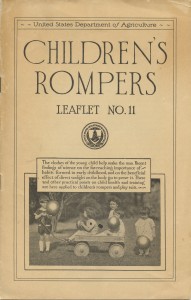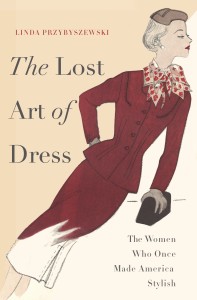By Linda Przybyszewski (Guest Contributor)
Your tax dollars paid for the publication of Children’s Rompers. At least they did if you were paying taxes in 1927, which was when the Bureau of Home Economics, housed at the U.S. Department of Agriculture, came out with the pamphlet. None of that may make sense at first reading, so let me explain.
The Bureau of Home Economics was created in 1923 as a way to serve farm women just as the U.S. Department of Agriculture had long been serving farmers. The Bureau contained several divisions, including one devoted to Textiles and Clothing, which did everything from testing fabrics for durability to trying to create standardized sizes in ready-to-wear. Its first head was Ruth O’Brien, a chemist who specialized in textile dyes. The Bureau actually became the largest employer of women scientists in the country. O’Brien had no luck with standardized sizes because it turns out that people would rather believe that they wear a size 8 than a size 12, so manufacturers just took a given size and give it a smaller number. She had better luck with children’s rompers.
Several impulses promoted the project. First, the home economists wanted to create simplified clothing that children could don and remove themselves. “Self-help” clothing would teach children to master basic hand skills and teach them to take initiative. Second, they worried that tight clothing hampered health and easy movement. Third, they wanted to change children’s clothing for reasons of hygiene. Traditional long skirts dragged in the dirt and might bring home diseases. Bare and translucent clothing exposed children to sunlight, which was called “a tonic and disinfectant in one” by scientists who reported that sunlight allowed the body to create vitamin D and killed off certain kinds of bacteria.
So the home economics designed clothing without hooks, snaps, or bows in favor of loops, tabs, and big buttons. They made up models and went to orphanages around Washington, DC and had the children try out bibs, sun-suits, sun-dresses, and rompers in the name of domestic science. When the pamphlet came out, the Bureau also sent out large posters with pictures and sewing patterns to the land-grant colleges around the country which ran public outreach programs called “extension” programs. By 1930, O’Brien reported that there was “a noticeable effect on children’s clothing throughout the country.” The children’s style revolution was complete.
Linda Przybyszewski is an award-winning historian and teacher who earned a Ph.D. at Stanford University and currently teaches at the University of Notre Dame. Trained as a legal historian, she has spoken at the United States Supreme Court. More recently, her research has taken a turn towards her first love: dressmaking.


